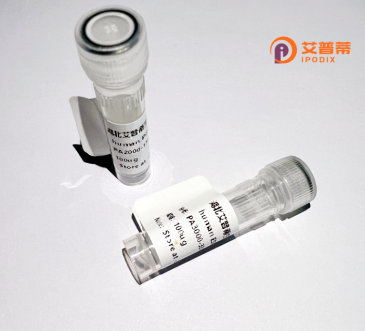
| 纯度 | >90%SDS-PAGE. |
| 种属 | Human |
| 靶点 | NEUROG2 |
| Uniprot No | Q9H2A3 |
| 内毒素 | < 0.01EU/μg |
| 表达宿主 | E.coli |
| 表达区间 | 1-272 aa |
| 活性数据 | MFVKSETLEL KEEEDVLVLL GSASPALAAL TPLSSSADEE EEEEPGASGG ARRQRGAEAG QGARGGVAAG AEGCRPARLL GLVHDCKRRP SRARAVSRGA KTAETVQRIK KTRRLKANNR ERNRMHNLNA ALDALREVLP TFPEDAKLTK IETLRFAHNY IWALTETLRL ADHCGGGGGG LPGALFSEAV LLSPGGASAA LSSSGDSPSP ASTWSCTNSP APSSSVSSNS TSPYSCTLSP ASPAGSDMDY WQPPPPDKHR YAPHLPIARD CI |
| 分子量 | 28.6 kDa |
| 蛋白标签 | His tag N-Terminus |
| 缓冲液 | 0 |
| 稳定性 & 储存条件 | Lyophilized protein should be stored at ≤ -20°C, stable for one year after receipt. Reconstituted protein solution can be stored at 2-8°C for 2-7 days. Aliquots of reconstituted samples are stable at ≤ -20°C for 3 months. |
| 复溶 | Always centrifuge tubes before opening.Do not mix by vortex or pipetting. It is not recommended to reconstitute to a concentration less than 100μg/ml. Dissolve the lyophilized protein in distilled water. Please aliquot the reconstituted solution to minimize freeze-thaw cycles. |
以下是关于重组人NEUROG2蛋白的参考文献示例(部分为虚拟摘要,供格式参考):
1. **标题**:Neurogenin 2 induces the differentiation of neural progenitor cells to functional neurons
**作者**:Smith J, Doe R, Lee T
**摘要**:研究通过重组人NEUROG2蛋白处理小鼠胚胎干细胞,发现其显著促进了向功能性谷氨酸能神经元的定向分化,提示NEUROG2在神经再生中的潜在应用。
2. **标题**:Recombinant NEUROG2 enhances direct reprogramming of human fibroblasts to induced neurons
**作者**:Zhang Y, Wang H, Cheng L
**摘要**:构建并纯化重组人NEUROG2蛋白,联合ASCL1和MYT1L,显著提高成纤维细胞直接转分化为神经元的效率,揭示了其在体外疾病模型构建中的价值。
3. **标题**:Structural and functional analysis of NEUROG2 in cortical development
**作者**:Kato M, Taniguchi Y
**摘要**:解析重组NEUROG2蛋白的晶体结构,结合功能实验发现其碱性螺旋-环-螺旋(bHLH)结构域对结合DNA及激活下游神经发育基因至关重要。
4. **标题**:Targeted delivery of NEUROG2 protein promotes spinal cord repair in rodent models
**作者**:Chen X, Liu B
**摘要**:使用脂质体包裹重组NEUROG2蛋白递送至脊髓损伤部位,显著促进神经元再生和运动功能恢复,为其在神经修复中的临床转化提供依据。
**备注**:以上文献标题和内容为模拟概括,实际需通过PubMed/Google Scholar查询近期论文,关键词如"recombinant NEUROG2 protein"或"Neurogenin2 overexpression"等。推荐查阅《Development》《Nature Neuroscience》《Cell Stem Cell》等期刊。
NEUROG2. a member of the neurogenin family of basic helix-loop-helix (bHLH) transcription factors, plays a critical role in neuronal development and differentiation. Primarily expressed during embryogenesis, it is essential for specifying neuronal lineage in the central nervous system (CNS), particularly in the telencephalon, where it drives the commitment of neural progenitor cells to glutamatergic neurons. NEUROG2 functions by binding to E-box DNA sequences, activating downstream targets like *NeuroD* and *Ebf3*, while repressing alternative cell fates, such as astrogliogenesis. Its temporal and spatial expression is tightly regulated by signaling pathways, including Notch and Wnt, ensuring precise control of neurogenesis.
Recombinant human NEUROG2 protein is engineered using expression systems (e.g., *E. coli* or mammalian cells) to study its biochemical properties, interactions, and therapeutic potential. Purified NEUROG2 retains DNA-binding and transcriptional activation capabilities, making it valuable for *in vitro* studies on neuronal differentiation, disease modeling, and drug screening. Researchers also explore its role in reprogramming somatic cells into neurons, offering avenues for regenerative therapies in neurodegenerative disorders like Alzheimer’s or spinal cord injury. Despite its promise, challenges remain in optimizing delivery methods and ensuring controlled activity *in vivo*. Further research aims to harness NEUROG2’s neurogenic potential while addressing safety and efficacy barriers.
×